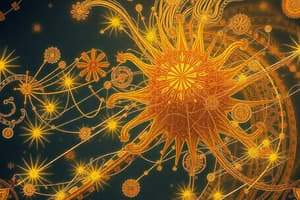Podcast
Questions and Answers
What is used in braking systems to slow down or stop vehicles?
What is used in braking systems to slow down or stop vehicles?
- Heat energy
- Friction (correct)
- Lubricants
- Molecular attraction
What provides traction and allows vehicles to accelerate, stop, and turn?
What provides traction and allows vehicles to accelerate, stop, and turn?
- Lubricants
- Molecular attraction
- Friction (correct)
- Heat energy
What is used in gearboxes to transmit force and power from one gear to another?
What is used in gearboxes to transmit force and power from one gear to another?
- Lubricants
- Molecular attraction
- Friction (correct)
- Heat energy
Which factor can reduce friction between surfaces and improve their movement?
Which factor can reduce friction between surfaces and improve their movement?
What is the force that opposes the starting of motion?
What is the force that opposes the starting of motion?
What type of friction is present when the surfaces are moving relative to each other?
What type of friction is present when the surfaces are moving relative to each other?
Which factor tends to increase friction?
Which factor tends to increase friction?
What causes resistance to motion and generates heat when two surfaces rub against each other?
What causes resistance to motion and generates heat when two surfaces rub against each other?
Study Notes
Introduction
Friction is a fundamental concept in physics and engineering, playing a crucial role in various aspects of our daily lives. It is the force that opposes motion and causes wear and tear on surfaces in contact. In this article, we will delve into the concept of friction, its types, causes, and the factors that affect it.
Types of Friction
There are two main types of friction: static friction and kinetic friction.
-
Static friction: This is the force that opposes the starting of motion. It is present when two surfaces are in contact but not moving relative to each other.
-
Kinetic friction: This is the force that opposes the motion of two surfaces in contact. It is present when the surfaces are moving relative to each other.
Causes of Friction
Friction is caused by the roughness and irregularities of surfaces in contact. When two surfaces rub against each other, the high points of one surface slide over the valleys of the other, causing resistance to motion and generating heat.
Factors Affecting Friction
Several factors influence the magnitude of friction between two surfaces:
-
Nature of the surfaces: The roughness and cleanliness of the surfaces have a significant impact on friction.
-
Pressure: The force applied per unit area between the surfaces can also affect friction. It tends to increase with the pressure.
-
Temperature: Friction generally decreases with increasing temperature.
-
Lubrication: The use of lubricants, such as oil or grease, can reduce friction between surfaces and improve their movement.
-
Molecular attraction: The attraction between molecules on the surfaces in contact can also contribute to friction.
Applications of Friction
Friction is essential in various applications, including:
-
Brakes: Friction is used in braking systems to slow down or stop vehicles by converting kinetic energy into heat.
-
Gearboxes: Friction is used in gearboxes to transmit force and power from one gear to another.
-
Clutches: Friction is used in clutches to connect and disconnect the engine from the transmission.
-
Tires: Friction between tires and the road surface provides traction and allows vehicles to accelerate, stop, and turn.
Conclusion
Friction is an essential concept in physics and engineering that plays a crucial role in various applications. Understanding the types, causes, and factors affecting friction can help us design more efficient and effective systems. By harnessing the power of friction, we can create braking systems, gearboxes, clutches, and tires that enhance our daily lives and make the world a safer and more enjoyable place.
Studying That Suits You
Use AI to generate personalized quizzes and flashcards to suit your learning preferences.
Description
Delve into the concept of friction, its types, causes, factors affecting it, and its applications in physics and engineering. Gain insights into static and kinetic friction, the impact of nature, pressure, temperature, lubrication, and molecular attraction on friction, as well as its crucial role in brakes, gearboxes, clutches, and tires.




